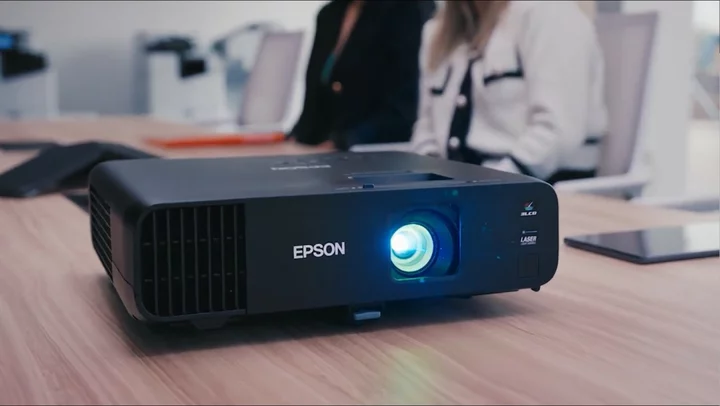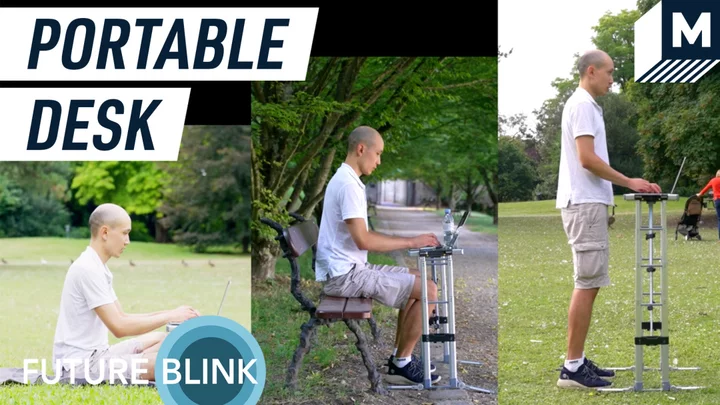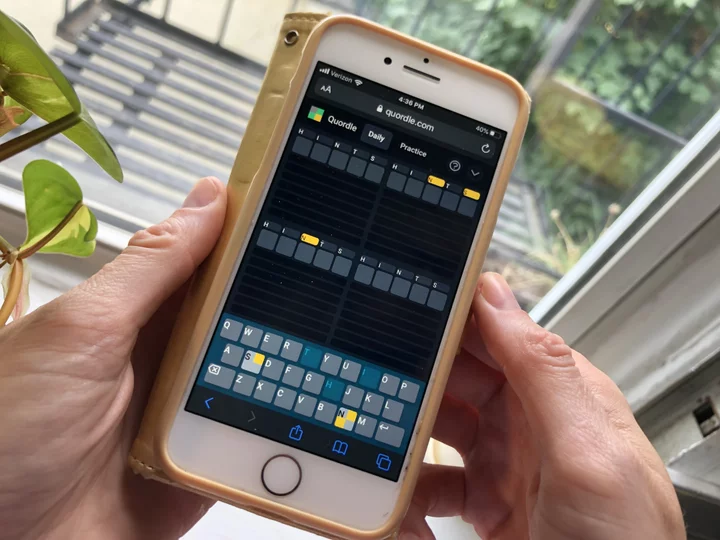The Epson Pro EX11000 is almost the same as the Pro EX10000 that it's replacing in Epson's line of portable projectors suitable for business and education use. You can still find the older version for sale; both have the same $1,299.99 list price, and most differences are minor. The 100-lumen boost in the EX11000's brightness rating, to 4,600 ISO lumens, is literally too small a difference to see, for example. However, Epson also makes one significant improvement to the EX10000, which eliminates artifacts in images and improves the readability of small fonts and details in graphics. In addition to being enough of a difference in image quality to notice, it's enough to earn the Pro EX11000 a higher score in our ratings.
A Lot to Lug Around (But You Can Do It!)
Although Epson lists the Pro EX11000 as a portable projector, its size and weight—4.1 by 12.8 by 11.8 inches (HWD) and 9.5 pounds—make it luggable at best, and really more appropriate for permanent installation, or at least setup on a cart. But if you need a 4,600-lumen projector for presentations in multiple rooms, you can use it as one, and Epson even adds a soft carrying case to make it less difficult to lug.
As with the Pro EX10000, the Pro EX11000 is built around a laser-phosphor light source meant to last the life of the projector, and Epson rates the light source at 20,000 hours in both Normal (full power) and Quiet (Eco) modes. Both models also use three LCD chips, which guarantees that you won't see any of the red/green/blue flashes known as rainbow artifacts that single-chip projectors can show. It also ensures that color images will be as bright as you would expect based on white brightness.
Both models claim to put a 1080p image on screen, but they differ in how they do that. The Pro EX10000 uses chips with only 1,366 by 768 pixels, then takes advantage of pixel shifting to actually put more pixels on the screen than are in a 1,920-by-1,080 array. The difference in pixel count between the input and output means the projector has to add pixels to and drop pixels from the original image to match the number on the screen, which often adds artifacts to repeating patterns, like floor tiles. It also tends to add a soft-focus effect to both small fonts and fine detail in graphics. In contrast, the Pro EX11000 uses native 1,920-by-1,080-pixel LCD chips, eliminating any need to scale 1080p images. It delivered much sharper images in our tests, with crisper, more readable text, as well as fine details in graphics.
Setting up the Pro EX11000 is standard. Set it down, connect the cables, and adjust the manual focus and 1.6x zoom. As with many laser projectors, you can pick a predefined power setting with an appropriate brightness level for room brightness and image size. Or, you can use a custom setting, which lets you fine-tune the power level, in 1% increments, from 70% to 100% of the maximum. The projector also offers a constant-brightness option, which automatically adjusts the power to compensate for the light source dimming as it ages, thereby maintaining the same image brightness over the projector's lifetime. (This obviously assumes you want a lower brightness level than the maximum available when new.)
(Credit: Epson)The Pro EX11000 can connect to just about anything you might want to use as an input source. Connection options include two HDMI ports, two VGA ports that double for component video (one of which can be set to use as a monitor-out port), a USB Type-B port for Epson's proprietary Plug 'n Play interface, a LAN port and Wi-Fi network support for both presentations and projector control, Wi-Fi Direct support for screen mirroring from a phone or tablet, and a USB Type-A connector for reading files from a USB key or powering an HDMI dongle. You'll even find a composite video port with RCA phono plug connectors. Note also that the projector supports Crestron Connected and Control4 for control over a network.
An important extra for some applications is a built-in option for showing a two-way or four-way split, so you can show images from up to four sources at once. A simple setup screen makes it easy to pick which source shows in which area on the screen and which source's audio to use.
(Credit: Epson)Another extra is Edge Blending, which is used in applications that project individual images from multiple projectors, as with a display along a hallway created by slightly overlapping images from by two or more units. The feature—which we didn't test, because we had only one Pro EX11000—is meant to blend the overlapping edges into a seamless, continuous image. It's not generally relevant to using the projector in a conference room or classroom.
The onboard 16-watt mono speaker offers high enough volume for a medium room, though it suffers from somewhat tinny audio quality. If you need higher volume, or better quality, you can connect an external audio system to the 3.5mm stereo audio-out port.
Testing the Epson EX11000: Top-Tier Graphics for Presentations
Most people will consider all but one of the Pro EX11000's picture modes, including the brightest, suitable for most presentations straight out of the box. The exception is Dicom Sim mode, which is meant for viewing X-rays, MRIs, and other medical images for education or similar purposes (but not meant for diagnosis).
Hues were noticeably different in our tests from one mode to the next, but all delivered vibrant, eye-catching color for graphics. Color accuracy ranged from good for Cinema mode to good enough (or at least tolerable) for the rest of the modes. None of the modes scored well for contrast, shadow detail, or black level, but these matter more for photorealistic images than for graphics, and the difference between good and poor performance for any of the three tends to get hidden in rooms with ambient light, where the Pro EX11000 is meant to be used.
(Credit: Epson/M. David Stone)After some preliminary tests, I picked Cinema as my preferred mode for most presentations, including most that include photorealistic images, largely because it scored best on color accuracy, and few presentations include the kinds of dark images where shortcomings in contrast, shadow detail, or black level would matter.
The image quality for film and video isn't a match for even a low-end home theater projector in any mode. However, it's at least watchable, except for extremely dark scenes, which makes the Pro EX11000 a better option for showing a video or movie than many other business and education models.
(Credit: Epson)My pick for for light scenes such as newscasts would be Cinema mode, because it offers the best color accuracy. For movies that might have dark scenes, such as our standard test clips, sRGB and Multi-Projection modes are both good compromises. They have decent color accuracy and better shadow detail than Cinema mode does. Both retained at least some of the shadow detail in our darkest test clips. Multi-Projection mode is actually designed to minimize color differences between projectors in applications that require more than one unit, as with displays that take advantage of Edge Bending, but nothing's stopping you from using it for other purposes.
Note that the Pro EX11000 does not support HDR or 3D. However it connected with our testbed PC at 3,840-by-2,160-pixel resolution and down-converted the image to its native 1080p. The projector's input lag came in at 54.5 milliseconds at 1080p/60Hz, as measured by my Bodnar meter.
Brightness is one of the Pro EX11000's key strengths. According to the Society of Motion Picture and Television Engineers (SMPTE) recommendations, 4,600 lumens is more than bright enough for a 300-inch, 1.0-gain, 16:9 screen in a dark room. In moderate ambient light, it's enough for a 175-inch image. In my tests, even the lower-brightness Cinema mode was easily bright enough to fill a 90-inch screen in a well-lit room.
Verdict: A Great Pick if You Don't Need 4K or HDR
The Epson Pro EX11000 is a solid choice as a 1080p business projector, whether you need an unusually bright portable model or plan to install it permanently in a conference room or classroom. As with most business projectors, it doesn't handle movies or video particularly well, but it offers good-enough color accuracy and contrast to make them watchable if you need to show them, which is more than many business projectors can manage. Plus, its lack of rainbow artifacts means that you don't have to worry about whether someone in the room sees them easily enough to find them annoying.
That said, if you're considering the Pro EX11000, also take a look at the Epson Pro EX9240, particularly if you're interested in the Pro EX11000 as a portable projector. The EX9240 is nearly as bright, about 3 pounds lighter, and costs less, thanks to using a traditional lamp for the light source. Also take a look at the BenQ LH730, a close competitor in many ways despite some notably different capabilities, including support for maintenance-free, 24/7/365 operation. It also scored higher on image quality than the Pro EX11000 did for movies and video, and it adds HDR support, making it a good choice if you include short clips as part of your presentations. However, it also showed frequent rainbow artifacts in our tests, making the Pro EX11000 the better choice for showing long stretches of video or film.









